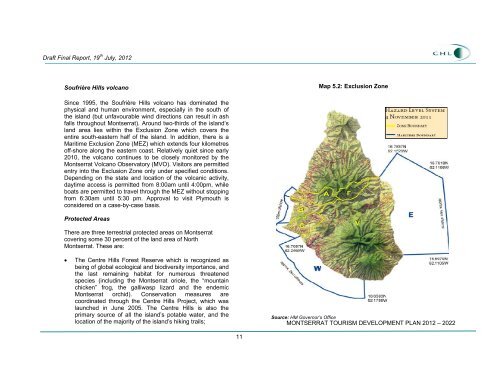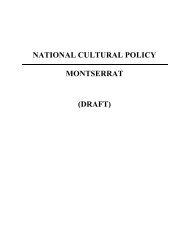downloadable - Visit Montserrat
downloadable - Visit Montserrat
downloadable - Visit Montserrat
Create successful ePaper yourself
Turn your PDF publications into a flip-book with our unique Google optimized e-Paper software.
Draft Final Report, 19 th July, 2012<br />
Soufrière Hills volcano<br />
Map 5.2: Exclusion Zone<br />
Since 1995, the Soufrière Hills volcano has dominated the<br />
physical and human environment, especially in the south of<br />
the island (but unfavourable wind directions can result in ash<br />
falls throughout <strong>Montserrat</strong>). Around two-thirds of the island’s<br />
land area lies within the Exclusion Zone which covers the<br />
entire south-eastern half of the island. In addition, there is a<br />
Maritime Exclusion Zone (MEZ) which extends four kilometres<br />
off-shore along the eastern coast. Relatively quiet since early<br />
2010, the volcano continues to be closely monitored by the<br />
<strong>Montserrat</strong> Volcano Observatory (MVO). <strong>Visit</strong>ors are permitted<br />
entry into the Exclusion Zone only under specified conditions.<br />
Depending on the state and location of the volcanic activity,<br />
daytime access is permitted from 8:00am until 4:00pm, while<br />
boats are permitted to travel through the MEZ without stopping<br />
from 6:30am until 5:30 pm. Approval to visit Plymouth is<br />
considered on a case-by-case basis.<br />
Protected Areas<br />
There are three terrestrial protected areas on <strong>Montserrat</strong><br />
covering some 30 percent of the land area of North<br />
<strong>Montserrat</strong>. These are:<br />
• The Centre Hills Forest Reserve which is recognized as<br />
being of global ecological and biodiversity importance, and<br />
the last remaining habitat for numerous threatened<br />
species (including the <strong>Montserrat</strong> oriole, the “mountain<br />
chicken” frog, the galliwasp lizard and the endemic<br />
<strong>Montserrat</strong> orchid). Conservation measures are<br />
coordinated through the Centre Hills Project, which was<br />
launched in June 2005. The Centre Hills is also the<br />
primary source of all the island’s potable water, and the<br />
location of the majority of the island’s hiking trails;<br />
Source: HM Governor’s Office<br />
MONTSERRAT TOURISM DEVELOPMENT PLAN 2012 – 2022<br />
11



